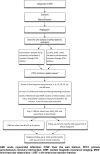The safety and efficacy of intracoronary nitrite infusion during acute myocardial infarction (NITRITE-AMI): study protocol of a randomised controlled trial
- PMID: 23550096
- PMCID: PMC3641434
- DOI: 10.1136/bmjopen-2013-002813
The safety and efficacy of intracoronary nitrite infusion during acute myocardial infarction (NITRITE-AMI): study protocol of a randomised controlled trial
Abstract
Introduction: Acute myocardial infarction (AMI) is a major cause of death and disability in the UK and worldwide. Presently, timely and effective reperfusion with primary percutaneous coronary intervention (PPCI) remains the most effective treatment strategy for limiting infarct size, preserving left ventricular ejection fraction (LVEF) and improving clinical outcomes. However, the process of reperfusion can itself induce cardiomyocyte death, known as myocardial reperfusion injury, for which there is currently no effective therapy. Extensive preclinical evidence exists to suggest that sodium nitrite (as a source of endogenous nitric oxide) is an effective therapeutic strategy for preventing myocardial reperfusion injury. The purpose of NITRITE-AMI is to test whether sodium nitrite reduces reperfusion injury and subsequent infarct size in patients undergoing PPCI for MI.
Methods and design: NITRITE-AMI is a double-blind, randomised, single-centre, placebo-controlled trial to determine whether intracoronary nitrite injection reduces infarct size in patients with myocardial infarction undergoing primary angioplasty. The study will enrol 80 patients presenting with ST-elevation myocardial infarction. Patients will be randomised to receive either a bolus of intracoronary sodium nitrite or placebo (sodium chloride) at the time of PPCI. The primary outcome is infarct size assessed by creatine kinase area under the curve (AUC) over 48 h. Secondary endpoints include troponin T AUC and infarct size, LV dimensions and myocardial salvage index assessed by cardiac MR (CMR), markers of platelet reactivity and inflammation, the safety and tolerability of intracoronary nitrite, and 1 year major adverse cardiac events.
Ethics and dissemination: The study is approved by the local ethics committee (NRES Committee London West London: 11/LO/1500) and by the Medicines and Healthcare Products Regulatory Agency (MHRA) (EudraCT nr. 2010-022460-12). The results of the trial will be published according to the CONSORT statement and will be presented at conferences and reported in peer-reviewed journals.
Trial registration: United Kingdom Clinical Research Network (Study ID 12117), http://clinicaltrials.gov (NCT01584453) and Current Controlled Trials (ISRCTN:38736987).
Similar articles
-
Protocol: does sodium nitrite administration reduce ischaemia-reperfusion injury in patients presenting with acute ST segment elevation myocardial infarction? Nitrites in acute myocardial infarction (NIAMI).J Transl Med. 2013 May 6;11:116. doi: 10.1186/1479-5876-11-116. J Transl Med. 2013. PMID: 23648219 Free PMC article. Clinical Trial.
-
A randomised double-blind control study of early intracoronary autologous bone marrow cell infusion in acute myocardial infarction (REGENERATE-AMI).BMJ Open. 2014 Feb 18;4(2):e004258. doi: 10.1136/bmjopen-2013-004258. BMJ Open. 2014. PMID: 24549163 Free PMC article. Clinical Trial.
-
Randomized phase 2 trial of intracoronary nitrite during acute myocardial infarction.Circ Res. 2015 Jan 30;116(3):437-47. doi: 10.1161/CIRCRESAHA.116.305082. Epub 2014 Dec 15. Circ Res. 2015. PMID: 25512434 Free PMC article. Clinical Trial.
-
The REFLO-STEMI (REperfusion Facilitated by LOcal adjunctive therapy in ST-Elevation Myocardial Infarction) trial: a randomised controlled trial comparing intracoronary administration of adenosine or sodium nitroprusside with control for attenuation of microvascular obstruction during primary percutaneous coronary intervention.Southampton (UK): NIHR Journals Library; 2016 Dec. Southampton (UK): NIHR Journals Library; 2016 Dec. PMID: 27929619 Free Books & Documents. Review.
-
Low-dose intracoronary alteplase during primary percutaneous coronary intervention in patients with acute myocardial infarction: the T-TIME three-arm RCT.Southampton (UK): NIHR Journals Library; 2020 Nov. Southampton (UK): NIHR Journals Library; 2020 Nov. PMID: 33175484 Free Books & Documents. Review.
Cited by
-
NIAMI: Towards the optimization of results in primary PCI.Glob Cardiol Sci Pract. 2014 Oct 16;2014(3):228-31. doi: 10.5339/gcsp.2014.35. eCollection 2014. Glob Cardiol Sci Pract. 2014. PMID: 25763373 Free PMC article.
-
Inorganic nitrite supplementation for healthy arterial aging.J Appl Physiol (1985). 2014 Mar 1;116(5):463-77. doi: 10.1152/japplphysiol.01100.2013. Epub 2014 Jan 9. J Appl Physiol (1985). 2014. PMID: 24408999 Free PMC article. Review.
-
Novel cardioprotective and regenerative therapies in acute myocardial infarction: a review of recent and ongoing clinical trials.Future Cardiol. 2016 Nov;12(6):655-672. doi: 10.2217/fca-2016-0044. Epub 2016 Oct 28. Future Cardiol. 2016. PMID: 27791385 Free PMC article. Review.
-
Intravenous sodium nitrite in acute ST-elevation myocardial infarction: a randomized controlled trial (NIAMI).Eur Heart J. 2014 May 14;35(19):1255-62. doi: 10.1093/eurheartj/ehu096. Epub 2014 Mar 17. Eur Heart J. 2014. PMID: 24639423 Free PMC article. Clinical Trial.
-
Cardiovascular magnetic resonance imaging of myocardial oedema following acute myocardial infarction: Is whole heart coverage necessary?J Cardiovasc Magn Reson. 2016 Jan 23;18:7. doi: 10.1186/s12968-016-0226-5. J Cardiovasc Magn Reson. 2016. PMID: 26803468 Free PMC article.
References
-
- Lambert L, Brown K, Segal E, et al. Association between timeliness of reperfusion therapy and clinical outcomes in ST-elevation myocardial infarction. JAMA 2010;303:2148–55 - PubMed
-
- Berger PB, Ellis SG, Holmes DR, Jr, et al. Relationship between delay in performing direct coronary angioplasty and early clinical outcome in patients with acute myocardial infarction. Results from the global use of strategies to open occluded arteries in acute coronary syndromes (GUSTO-IIb) trial. Circulation 1999;100:14–20 - PubMed
-
- McNamara RL, Wang Y, Herrin J, et al. Effect of door-to-balloon time on mortality in patients with ST-segment elevation myocardial infarction. J Am Coll Cardiol 2006;47:2180–6 - PubMed
-
- Cannon CP, Gibson CM, Lambrew CT, et al. Relationship of symptom-onset-to-balloon time and door-to-balloon time with mortality in patients undergoing angioplasty for acute myocardial infarction. JAMA 2000;283:2941–7 - PubMed
Associated data
Grants and funding
LinkOut - more resources
Full Text Sources
Other Literature Sources
Medical

